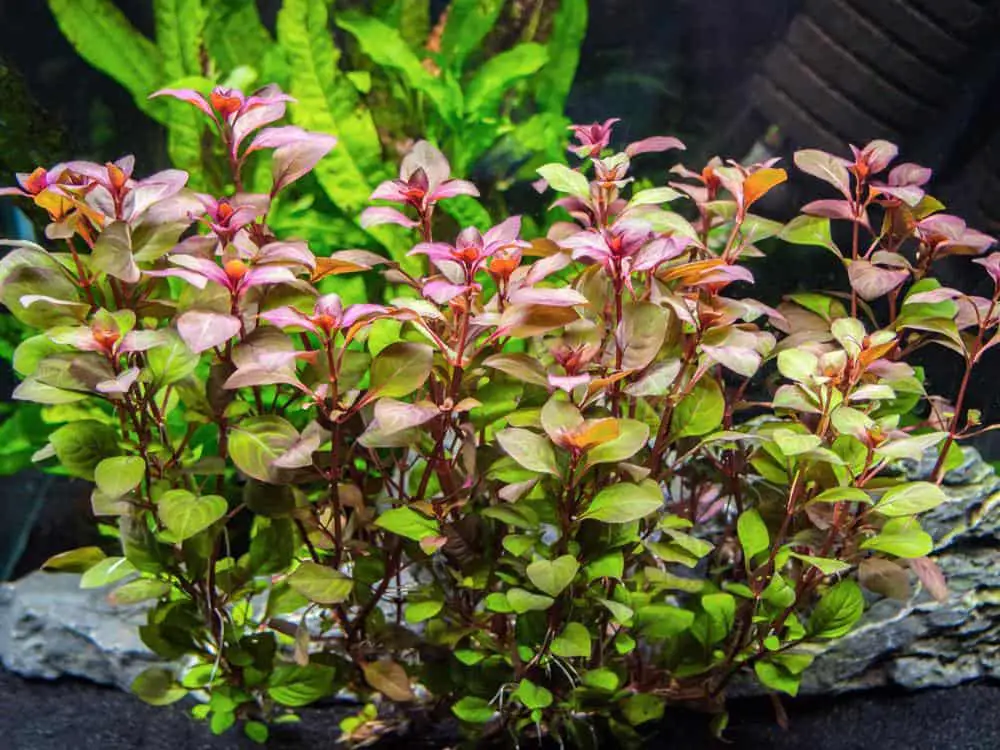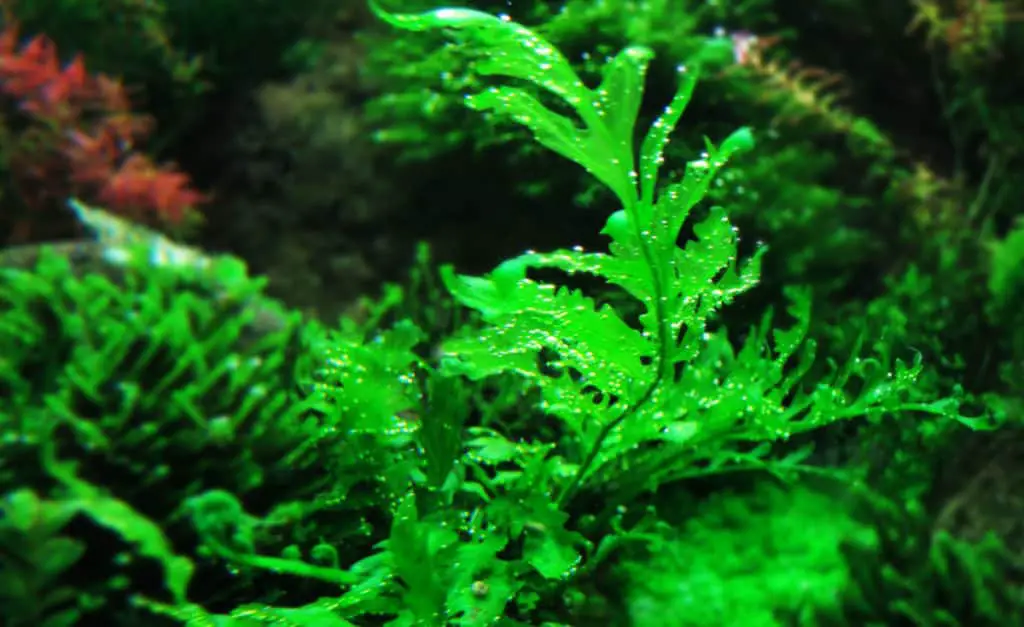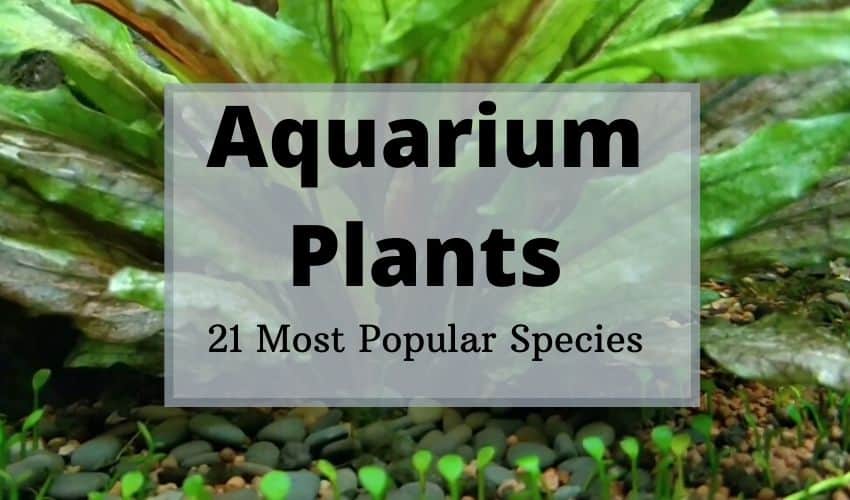Best Aquarium Plants | 21 Popular Plants For A Home Aquarium
Photo by Delbert Pagayona Originally Posted On: https://fishkeepingforever.com/aquarium-plants/ If you’ve ever owned a freshwater aquarium then you’ll know how beautiful they can look with real live...Monday, February 24th 2020, 12:39 pm
Photo by Delbert Pagayona
Originally Posted On: https://fishkeepingforever.com/aquarium-plants/
If you’ve ever owned a freshwater aquarium then you’ll know how beautiful they can look with real live aquarium plants. In this article, we’ll look at 21 Popular species of aquarium plants which are perfect for the home aquarium. We have listed 21 of the Best Aquarium Plants sold throughout the world for freshwater aquariums.
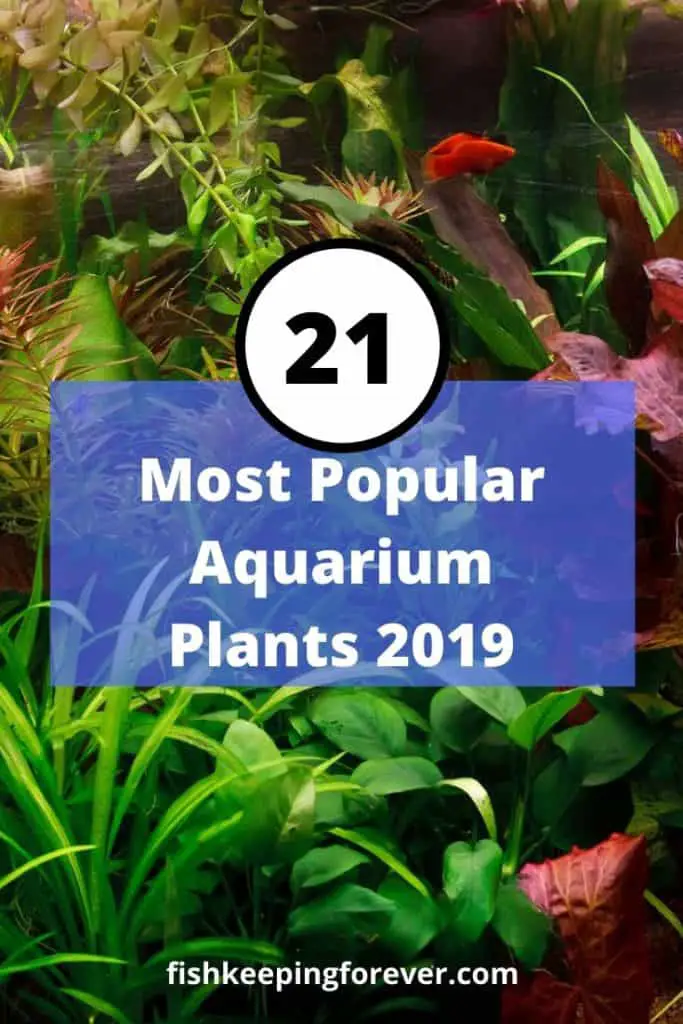
Don’t get me wrong, plastic plants have their place in the hobby but nothing can beat the look of a fully planted freshwater aquarium full of healthy live aquatic plants.
Plants play a vital role in your aquarium they offer shelter for your fish and a place for your fish to breed and take care of their young.
But by far the biggest benefit of having live aquarium plants in your fish tank is the fact that they produce oxygen (O2) and absorb the carbon dioxide (CO2) and ammonia (NH3) that your fish generate. This is beneficial for the growth and survival of the inhabitants of your aquarium.
Table of Contents
What Are The Best Aquarium Plants?
- Moneywort
- Hornwort
- Rotala Rotundifolia
- Pygmy Chain Sword
- Hygrophilia Polysperma
- Cryptocoryne Wendttii
- Anubia Nana
- Java Fern
- Amazon Sword
- Java Moss
- Water Lettuce
- Vallisneria Spirallis
- Cryptocoryne Balansae
- Elodea Densa
- Red Ludwigia
- Marimo Ball
- Duckweed
- Water Wisteria
- African Water Fern
- Tiger Lotus
- Cryptocoryne Beckettii
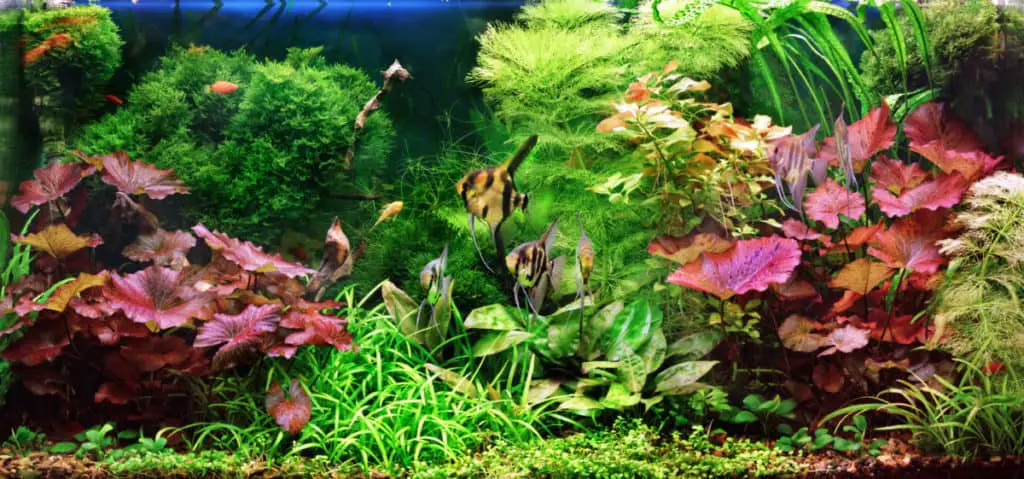 A beautifully planted aquarium with some of the plants in our list
A beautifully planted aquarium with some of the plants in our list
21 Most Popular Aquarium Plants
21. Moneywort
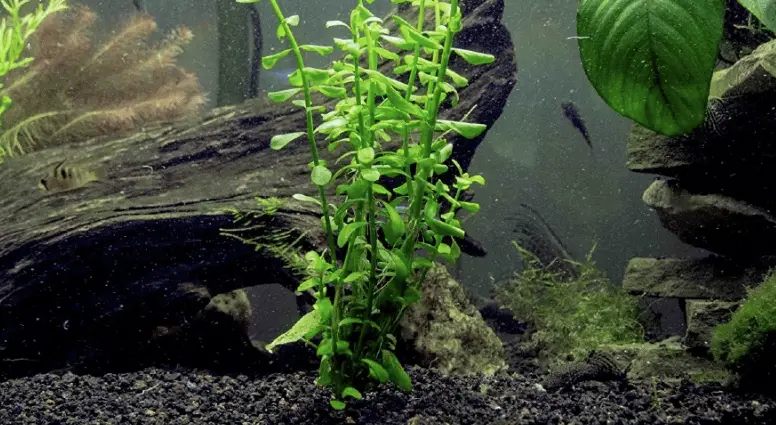
Species Data
Scientific Name Bacopa monnieri
Family Scropulariacase
Care Level Moderate
Max Size 12 inch
Propagation Seeds & Cuttings
Color Green
Water Conditions 72-82° F, KH 3-8, pH 6.5-7.5
Moneywort, also known as Brahmi to herbalists, is an easy-to-grow aquarium plant perfect for freshwater home aquariums.
Bright green and almost lime in coloration under the right lighting conditions makes it an attractive addition to any aquarium. They are amphibious and will grow either partially or fully submersed.
Moneywort grows to 12 inches tall on average but under the right conditions can grow even taller. It is often seen growing horizontally until it reaches the water’s surface. If left untrimmed, it will extend its branches out of the water. It is used in aquariums and vivariums alike thanks to its ability to grow both underwater and above the water level.
It can be susceptible to fluctuating water temperatures and can quickly deteriorate if your water temperature isn’t stable. If you would like more information on How to grow moneywort in a home aquarium then take a look at our complete growers guide here.

20. Hornwort
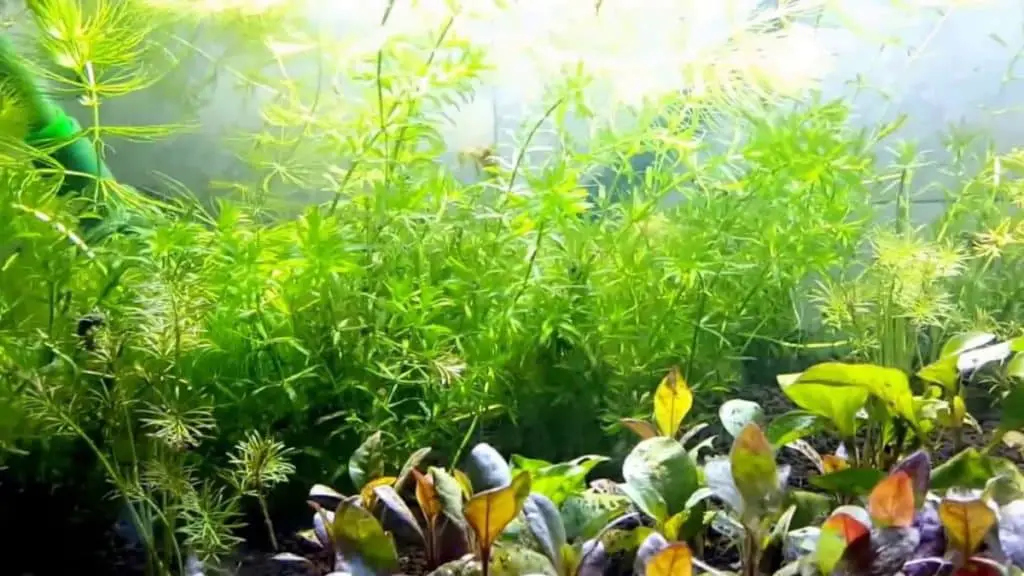
Species Data
Family Ceratophyllaceae
Scientific Names Ceratophyllum demursum
Care Level Easy
Color Green
Max Size 24 inch
Water Conditions 59-86° F, KH 5-15, pH 6.0-7.5
Propagation Side Shoots
Hornwort is one of the easiest aquarium plants to grow and can be grown floating or rooted in the aquarium substrate.
This aquarium plant is very hardy and fast-growing and in the wild can be seen as a negative as it has been known to totally take over and dominate rivers. This has become a problem in places such as New Zealand where it is out-competing native plant species.
This plant grows fast and provides a thick/dense area for your fish to escape and hide amongst. It often sheds its leave which can provide a food source for some fish. If this becomes too excessive you can simply remove the excess leaves floating on the surface with a fine net.
Hornwort is a lovey plant; dark green in color, though lighter green shades of leaves will appear in warmer waters.
Highly recommended for beginners thanks to it being hardy and easy to grow.
Complete Hornwort Growers Guide Here!
19. Rotala Rotundifolia
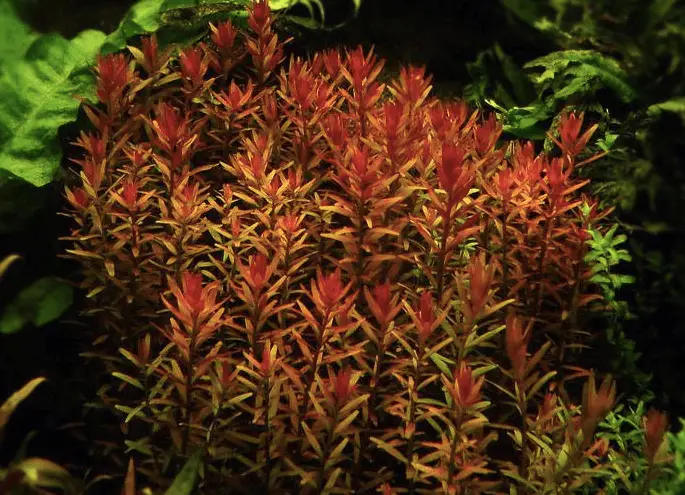
Species Data
Scientific Name Rotala Rotundifolia
Family Lythraceae
Care Level Very Easy
Color Green/red
Max Size 30-50 cm
Water Conditions 4 – 32°C Carbonate hardness 0 – 21°dKH
General hardness 2 – 30°dGH
Light Levels Low
Propagation Cuttings
Origin South East Asia
Cost $6-8
Placement Mid-Background
If you’re looking to add a splash of color to your aquarium you can’t go wrong by adding some Rotala Rotundifolia.
Rotala Rotundifolia originates from South-East Asia with 15-30cm long stems and long, narrow leaves. Rotala species are easy growing and plants which are perfect for most home aquariums although it needs good light to produce red leaves.
Complete Growers Guide for Rotala Rotundifolia here!
Word of warning: Fish love to eat this plant so if you have larger plant-eating fish it may not last long. However, in a community aquarium with a selection of small peaceful tropical fish, it will be a good addition.
It grows side shoots and forms a compact and bushy plant.
This can cause issues in low lighting as it’s hard for light to reach the lower leaves, so the plant should be pruned frequently.
18. Pygmy Chain Sword ( Narrow Leaf )
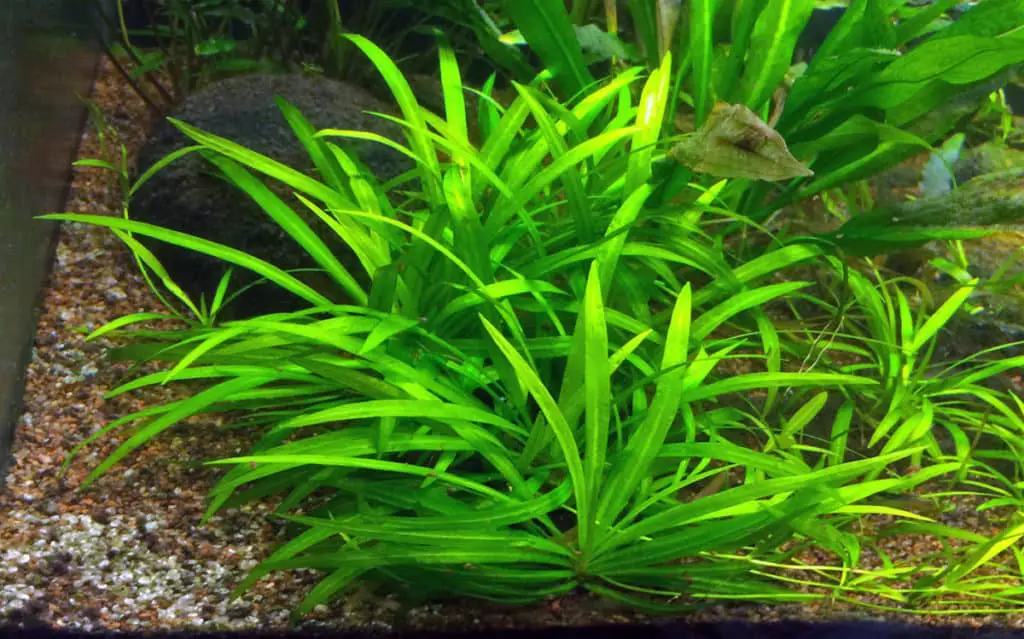
Species Data
Scientific Name Echinodorus tenellus
Family Alismataceae
Care Level Moderate
Color Green
Max Size 6 Inch
Light Level Medium
Propagation Adventitious Plants, Runners, Seeds
If you’re looking for a plant for the foreground of your aquarium this is it. Under the right lighting conditions, it can form a beautiful carpet of light green which will grow and spread quickly.
It’s okay in most temps from 65 up to 80 degrees but grows better if rooted in soil/plant substrate as it needs plenty of nutrients to thrive.
The runners that grow off of healthy adult plants will propagate across the bottom of your aquarium. When the plant is young – about half the size of a fully grown plant – you can divide the roots so they may grow separate from one another. This is the quickest way to grow more and form a carpet across the foreground of your aquarium.
Pygmy Chain Sword can also produce seeds that can be used to cultivate new plants and be used for propagation.
17. Hygrophilia Polysperma
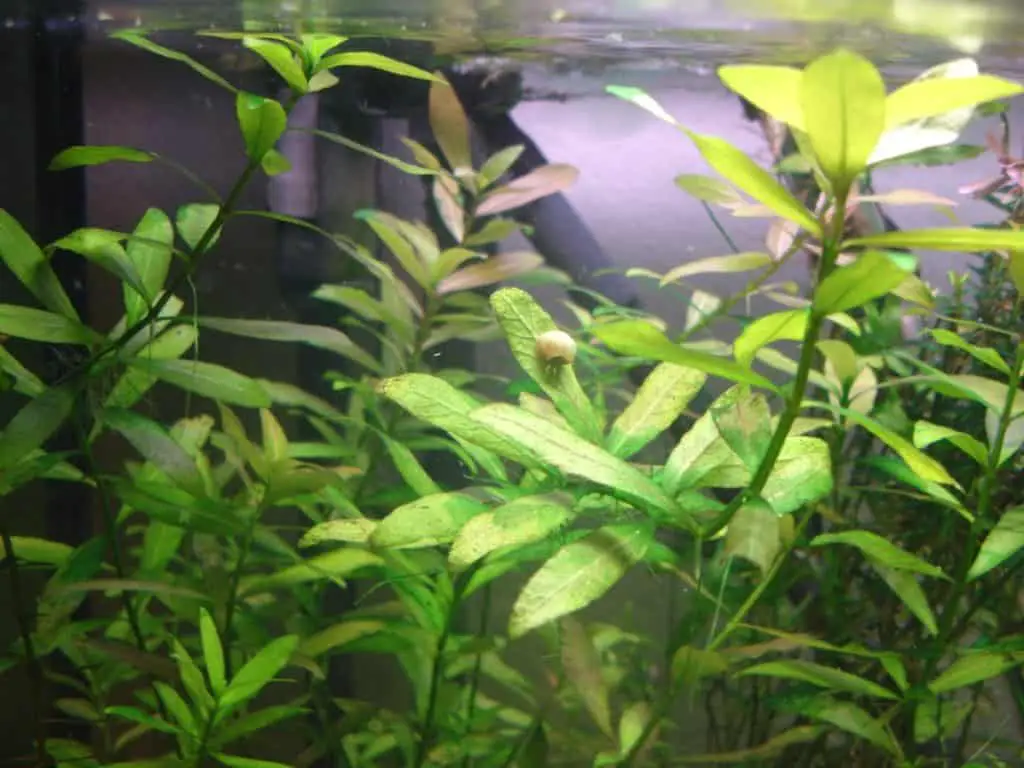
Species Data
Common Names Dwarf hygro, Indian waterweed, Dwarf hygrophila
Family Acanthaceae
Care Level Easy
Color Green/Red
Max Size 24 Inch
Water Conditions 5-8 pH and Soft to Moderately Hard
Temperature: 64–86 °F (18-30 °C)
Light Levels Low-Moderate
Propagation Division/Splitting
This is one of my favorite aquarium plants. It looks very delicate but is actually very hardy and easy to grow. It’s also commonly available in most aquarium stores and I would recommend any beginner to try this plant.
This aquarium plant is so easy to grow it will often need to be trimmed to stop it blocking out and overtaking other plants. Simply pinch and break off stems to prune.
Hygrophila Polysperma varies considerably in leaf shape and color, depending to some extent on the light supplied.
This is the perfect plant for most tropical fish aquariums. Even leaves that break off and float on the surface will start to propagate and grow if not removed. Read our Complete Growers Guide for this plant here!
16. Cryptocoryne Wendttii

Species Data
Family Araceae
Care Level Easy
Color Green/Brown
Max Size 6 Inch
Light Level Moderate
Propagation Runners
Placement Front-Mid
Water Conditions 72-78° F, KH 3-8, pH 6.0-8.0
Crytopcoryne Wendtii is the perfect foreground aquarium plant for aquariums with slightly harder water but will grow in most aquarium water conditions.
Cryptocoryne wendtii ‘Green’ presents beautiful, green leaves and a height from 10-15 cm with a rosette from 8-15 cm wide. It is also available in brown color depending on lighting conditions. In fact, there are several varieties of Cryptocoryne wendtii.
Originally native to Sri Lanka where it is commonly found in streams and rivers and grows in shaded areas. It has become established as an invasive species in Florida in recent years which is proof of its hardiness and ability to grow in various water conditions.
To propagate this aquarium plant you can simply separate and divide the roots and re-plant in a different area of the aquarium. The roots will quickly take hold and grow. I have found it one of the easiest Cryptocorynes to propagate. Read our Complete Growers Guide for this plant here!
15. Anubia Nana
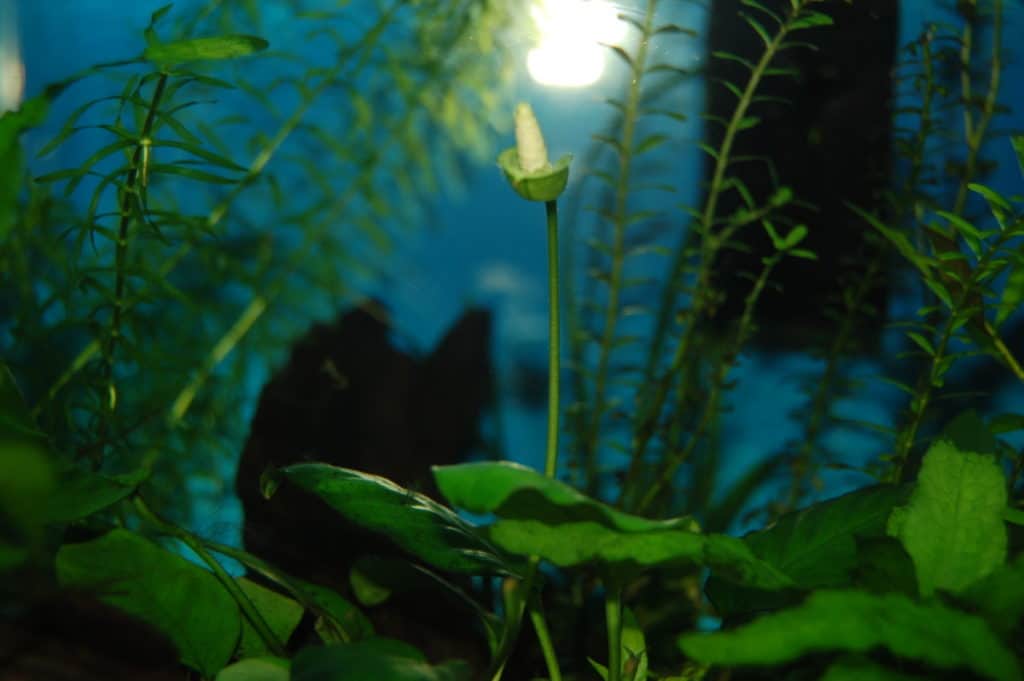
Species Data
Scientific Name Anubia Nana
Family Araceae
Care Level Easy
Color Green
Water Conditions 72-82° F, KH 3-8, pH 6.0-7.5
Light Levels Moderate
Max Size 7-8 Inch
Placement Foreground
Propagation Rhizome Division
If you’re looking for a plant that will attach to rocks and driftwood, Anubias Nana may be the one for you.
This dark gree, thick-leaved plant will attach to any rocks or wood you place near or on it. It grows with ease – partially or fully submersed – however the rhizomes must be above the aquarium substrate or attached to rocks or wood.
It will grow in a range of temperatures which will be found in most home tropical aquariums 72-82 degrees F (22-28 degrees C). Propagation is simple by dividing the rhizome or by separating side shoots.
The leaves have a thick dark appearance and are very hardy which can withstand fish that like to attach themselves to leaves like Plecostomus and Algae Eaters or even fish that like to eat plant leaves.
One word of warning… You will need to remove any leaves that become detached or die from your aquarium quickly. They can soon rot and if sucked up into your filter can cause a mess.
14. Java Fern

Species Data
Scientific Name Microsorum pteropus
Family Polypodiaceae
Care Level Easy
Color Green
Max Size 7-8 Inch
Light Level Low-Moderate
Water Conditions 68-82° F, KH 3-8, pH 6.0-7.5
Propagation Rhizome Division, Adventitious Plants
Java fern is another aquarium plant that is perfect for attaching to rocks and wood. It’s a relatively slow-growing plant but once established grows well.
It’s native to parts of Southeast Asia and was first described by Dutch-German botanist Karl Ludwig Blume in 1833.
It typically grows along the banks of freshwater rivers and streams in Thailand, Malaysia, India and China.
Java fern produces pods on the leave which can propagate into new plants. The base of the plant has a thick twig-like structure that needs to be above the substrate. Ideally attached to rocks or wood. If this part of the plant is submerged under gravel it will rot away and die.
Java Fern is perfect for recreating that amazon river bed look and is often used in cichlid aquariums with plenty of driftwood and rocks.
Most fish won’t eat Java fern. so once attached to rocks or driftwood, it has a good chance of survival and will grow even under low lighting conditions.
13. Amazon Sword
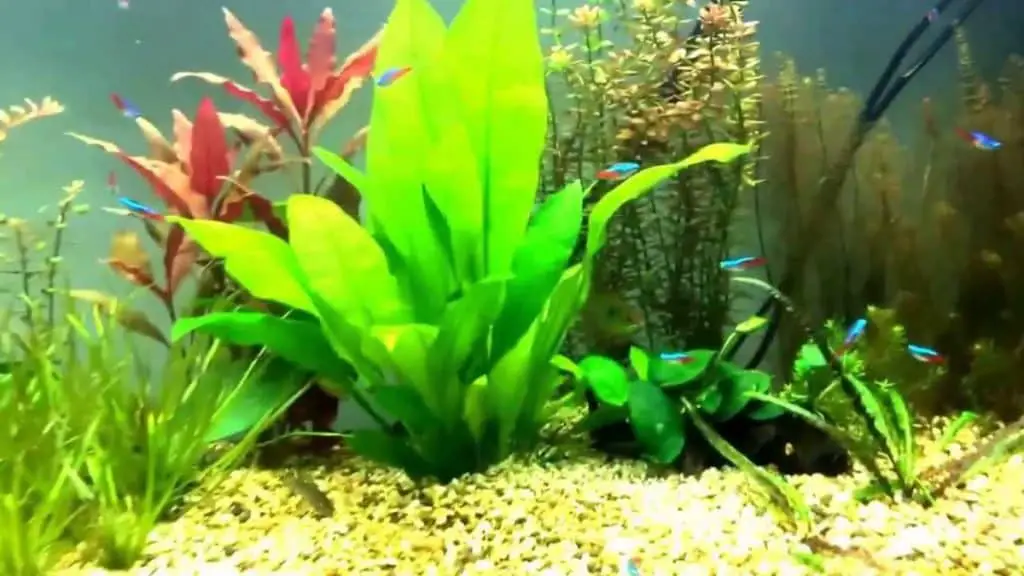
Species Data
Scientific Name Echinodorus amazonicus
Family Alismataceae
Color Green
Care Level Moderate
Light Level Low-Moderate
Max Size 19-20 Inch
Water Conditions 72-82° F, KH 3-8, pH 6.5-7.5
Propagation Peduncles
Anyone who has ever kept a tropical fish aquarium will have kept Amazon Swords – I would bet my bottom dollar on it. Today, the Amazon sword is still one of the most commonly sold aquarium plants.
It originates from the extremely diverse and beautiful Amazon River basin and takes it’s common name Amazon sword from its blade-like looking leaves.
Often used as part of aquascaped aquariums in the background, this plant can grow to 15-18 inches which is mainly made up of leaves. This easy to grow plant is perfect for most aquariums thanks to its tolerance of aquarium water temperature and water quality.
Inexpensive and readily available in most stores it’s no wonder Amazon is so popular.
Its rootstock (rhizome) can grow large and penetrate deep into the substrate; which could cause issues if you use under gravel filters.
The leaves are light in color and spread out widely reaching the top of most aquariums.
Amazon sword will grow in most environments and food supplements are not really needed to make this plant thrive. Read our complete guide to growing and caring for Amazon Sword Plants Here!
12. Java Moss
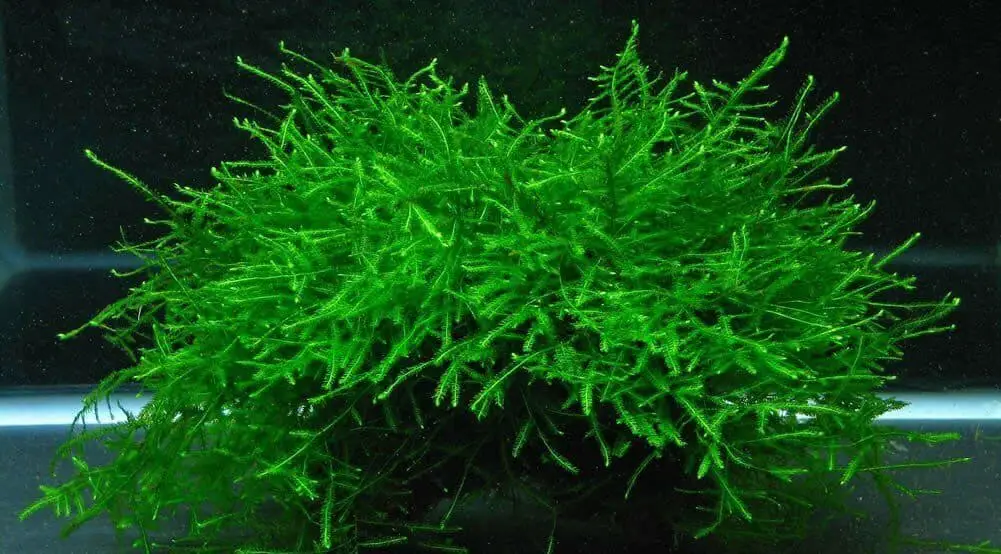
Species Data
Scientific Name Taxiphyllum barbieri
Family Name Hypnaceae
Color Green
Max Size 3-4 Inch
Water Conditions
Care Level Moderate
Light Level Low
Water Conditions 59-82 Fahrenheit (15-28 Celsius)
pH: 5.5-8.0
Hardness: 6-20 dGH
Propagation
Placement Foreground
Another plant that is well suited to growing on rocks and driftwood. Native to Southeast Asia including Indonesia, Japan, Java, Malaysia, Philippines, Singapore, Vietnam; Java fern can be found attached to rocks and wood above and below the native water levels.
The elongated oval-shaped leaves, bright green in color of the submerged types of Java moss are much smaller than those that grow on land.
This aquatic plant is best suited to aquarium temperatures between 70 to 75° Fahrenheit (21 to 24° Celsius) but can live in temperatures as high as 85 to 90 °F (29 to 32 °C)
Java moss not only looks attractive and can add a different dimension to the look and feel of your aquarium but it can also be beneficial for your fish. Java moss can provide food for the newly formed fry, which can be challenging to feed and also provide shelter for smaller fish and shrimps.
We like floating Java moss on the surface of the aquarium, where newly hatched fry is present; it helps provide safety and security from predators.
Java moss can quickly provide an amazing carpet effect across wood and sandy substrate in most home aquariums. We attach ours using elastic bands until the roots have taken hold then we simply cut away the bands to leave the moss attached to the required surface. Normally this process takes between 2-4 weeks depending on your lighting.
11. Water Lettuce
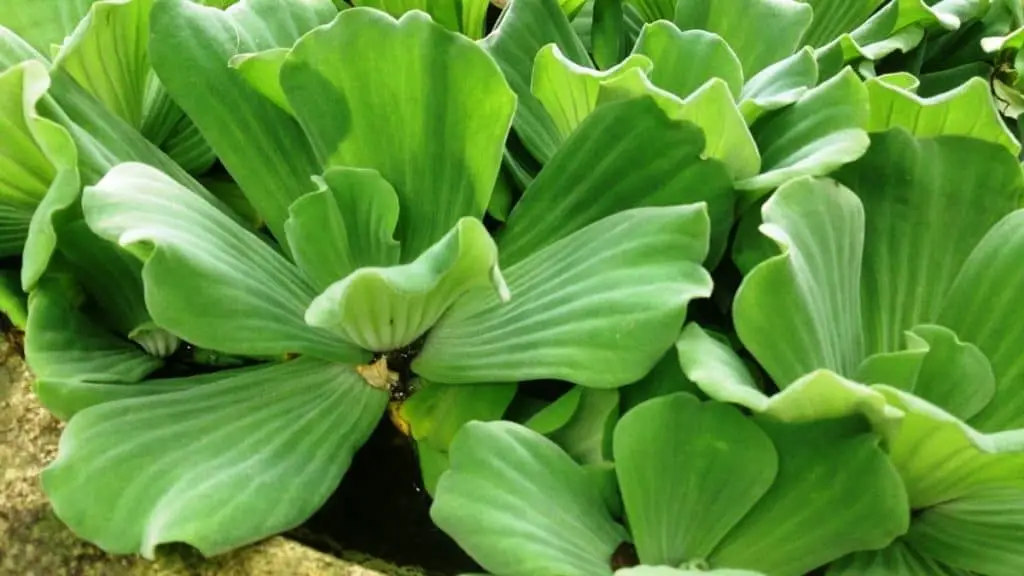
Species Data
Scientific Name Pistia stratiotes
Family Araceae
Color Green
Light Levels Natural light-Medium
Care Level Easy
Water Conditions 70-80° F, pH 6.5-7.5
Placement Floating
Propagation Viviparous
Walk into any garden center and look at the plant selection and you’ll be sure to find water lettuce. Mostly used in ponds and coldwater aquariums it is the perfect surface plant for providing color, protection and shade for many ponds and aquariums.
Often called water cabbage or Nile cabbage, it is better suited to ponds and coldwater fish tanks rather than tropical aquariums.
This isn’t to say it can’t be used successfully in warmer waters.
This plant can grow between 8-10 inches in size but is usually smaller if kept in a home aquarium. Water lettuce grows floating on the surface water, and its leaves form a rosette, with dense, submerged roots beneath it.
A lovely plant but in my opinion, there are better suited floating plants for a home tropical fish tank. This one is best left for ponds and small container/patio ponds.
Water lettuce is compatible with most tropical fish, although larger fish have a tendency to eat the roots which will quickly kill off the plant. Any home aquariums containing Goldfish or Koi or any other large herbivore fish should be avoided as they tend to eat the roots, and even the plant itself. Read more information on water lettuce here!
10.Vallisneria Spirallis
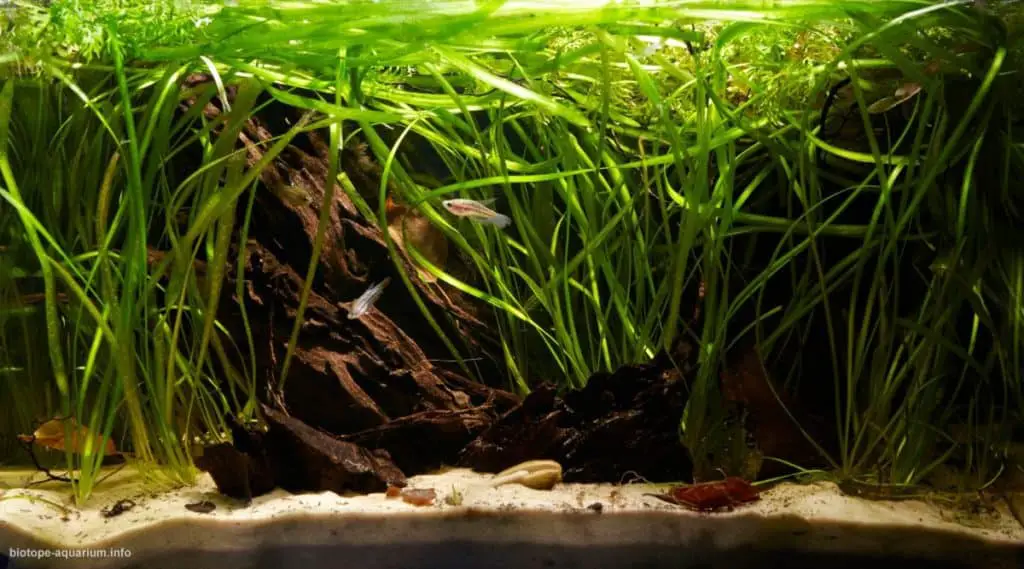
Species Data
Family Hydrocharitaceae
Care Level Easy
Color Green
Max Size 17-20 Inch
Placement Background
Light Level Moderate
Water Conditions Ph 6-9 Temp range 16-30C
Propagation Runners
The short leaves make this plant suitable for small aquariums; the leaves are also thin enough as not to overshadow smaller plants.
Vallisneria Spirallis is one of the easiest plants to propagate in a home aquarium by means of runners.
Planting Vallisneria can be a little bit tricky until the roots take hold in your substrate. It has a habit of floating up to the surface until the roots have taken hold in your aquarium substrate – which usually takes around 5-7 days.
It is advisable not to plant your Vallisneria too deep. If you bury the light part at the bottom of the leaves, known as the crown, you may find them dying off after a while.
Used mainly as a background plant thanks to its ability to grow very long and to the top of your aquarium. From there, the leaves will continue to grow and float on the surface. With plenty of water movement, it will look incredible. Like an Amazon river effect. Read more information on Vallisneria spiralis in our more detailed article here!
9. Cryptocoryne Balansae

Species Data
Family Araceae
Care Level Moderate
Light Level Medium
Max Size 16-18 Inch
Color Green/Brown
Placement Mid-Background
Water Conditions 72-82° F, KH 3-8, pH 6.5-7.5
Propagation Runners, Seeds
Another very popular aquarium plant for the foreground of your tank is Cryptocoryne Balansae. This beautiful looking plant with its thin green patterned leaves will be a great addition to any aquarium.
This species hails from Southern Thailand where it inhabits fast-flowing rivers and streams with high limestone content. Balansae plants thrive in an environment that is rich with nitrate, phosphate, iron, CO2, and calcium.
Providing you have the correct lighting, Cryptocoryne Balansae will take on a green speckled coloration and some will also flower given the correct water and lighting conditions.
Cryptocoryne Balansae is used not only in submerged aquariums but also in vivariums and plant displays as it can be grown outside of the water. When grown outside of water the leaves become shorter, less ruffled, and often become rounded when grown on dry land.
The additions of CO2 and aquarium plant fertilizers that are rich in iron will really help this plant thrive as they are known to suffer from iron deficiencies. It is not essential, so don’t let it put you off trying this aquarium plant species; I have had great success without them but it will help.
8. Elodea Densa
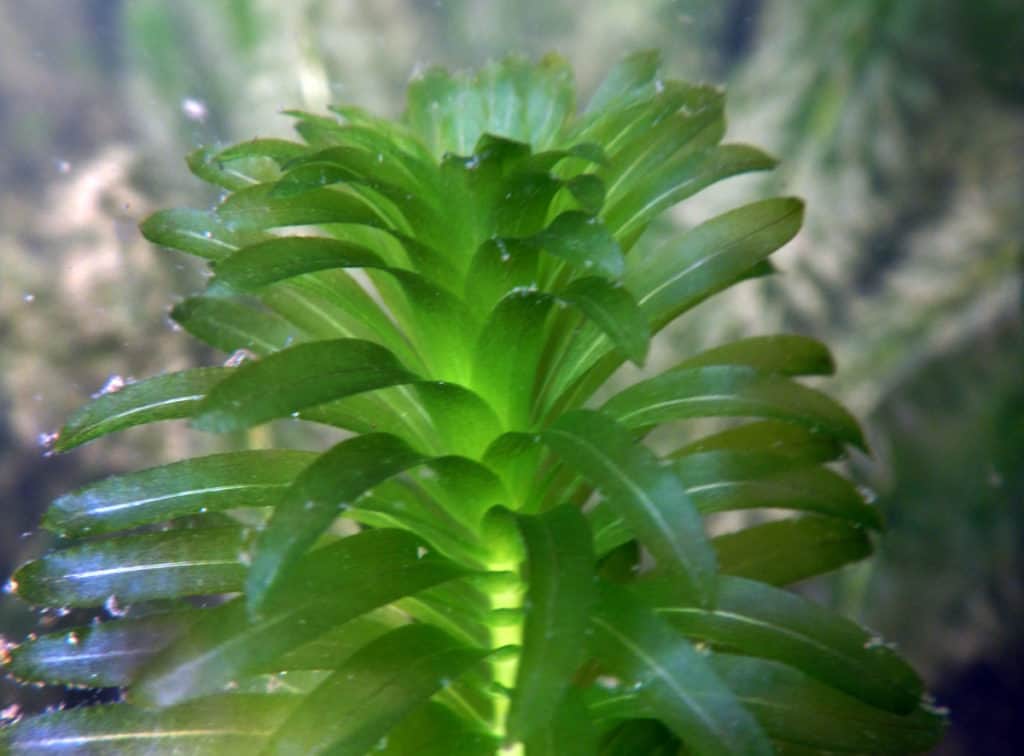
Species Data
Family Hydrocharitacea
Care Level Easy
Color Green
Light Level Low
Water Conditions 59-82° F, KH 3-8, pH 6.5-7.5
Max Size 24 Inch
Placement Background
Propagation Background
Probably known best as a popular oxygenating plant, which is often sold with goldfish and goldfish bowls and smaller aquariums.
Thought of as a pond or coldwater plant, Elodea densa actually is just as at home in warmer waters. This is because it’s actually native to warm temperate South America in southeast Argentina, Brazil, and Uruguay.
Thanks to its ability to adjust to varying water conditions, it is now considered a problematic and invasive species due to its popularity in home aquariums and subsequent release into non-native habitats. In certain rivers and ponds, it has completely overtaken native wildlife plants and suffocated them into decline.
It is known for its ability to add essential oxygen into aquariums and ponds but it can also help to prevent algae because it absorbs a great number of nutrients from the water.
Still today Elodea Densa is the most popular aquarium and pond plant and is sold around the world to millions each year. Inexpensive, fast-growing, beneficial and good looking it’s no wonder it’s the number one choice for most beginners.
7. Red Ludwigia
Species Data
Family Onagraceae
Color Red
Care Level Moderate
Lighting Level Low-Moderate
Water Conditions 72-82° F, KH 3-8, pH 6.5-7.5
Max Size 16-18 Inch
Placement Midground
Propagation Cuttings, Seeds
Red Ludwigia is an amphibious plant which means it can be grown fully submerged in an aquarium or partially submerged making it suitable for different aquariums, vivariums and plant displays.
Given the right lighting conditions in a home aquarium, the leaves will be red and green; if used partially submerged they are lighter green in color.
The red color is even more vibrant and intense if the correct lighting conditions are provided. A medium to high lighting is perfect 2 – 4 watts per gallon will be fine. If kept in low-light tanks, the color will fade and the leaves tend to fall off and rot.
This is and has always been one of my go-to plants for the middle of the aquarium; to add a splash of color and provide great cover for fish to live amongst.
6. Marimo Ball
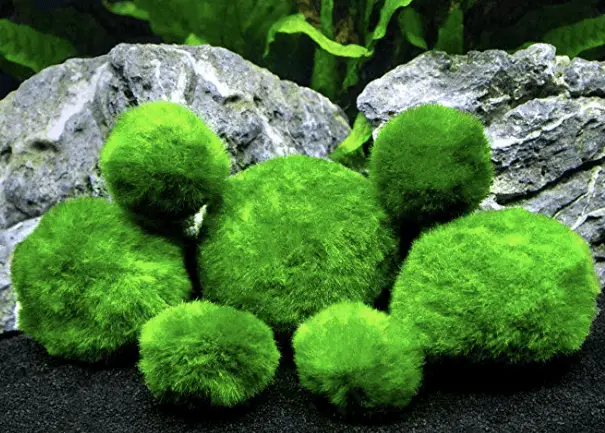
Species Data
Common name Moss Balls
Scientific Name Chladophora aegagropila
Growth rate Slow
Color Green
Care Level Easy
Lighting Moderate
Water Conditions 72-82° F, KH 3-8, pH 6.8-7.5
Family Cladophorales
Propagation Division
This is, without a doubt, one of the most unusual types and species of aquarium plants available for sale. This species is found in lakes and rivers in Japan and Northern Europe. However, Colonies of Marimo balls are in decline in parts of Japan and Iceland. This is partly due to them being seen as a symbol of good luck in the far East and collected and given as gifts.
They are now considered a national treasure. Also found in parts of Europe and Iceland, they are considered endangered and are protected in both Japan and Iceland.
They prefer cool water below 77°F (25°C) and live at the bottom of your aquarium. They need clean, filtered water to thrive like any other plant.
Marimos can live for many years and even be passed from generation to generation as a unique living keepsake.
Marimo balls are very hardy and can withstand various attacks and curious fish nipping with ease. Their spongy texture also allows them to act as a filter, removing phosphates and particulates from the tank. Like many plants they photosynthesize; it takes in carbon dioxide and releases oxygen as well as consuming nitrates.
So, not only do these plants look amazing they are extremely beneficial for your fish.
5. Duckweed
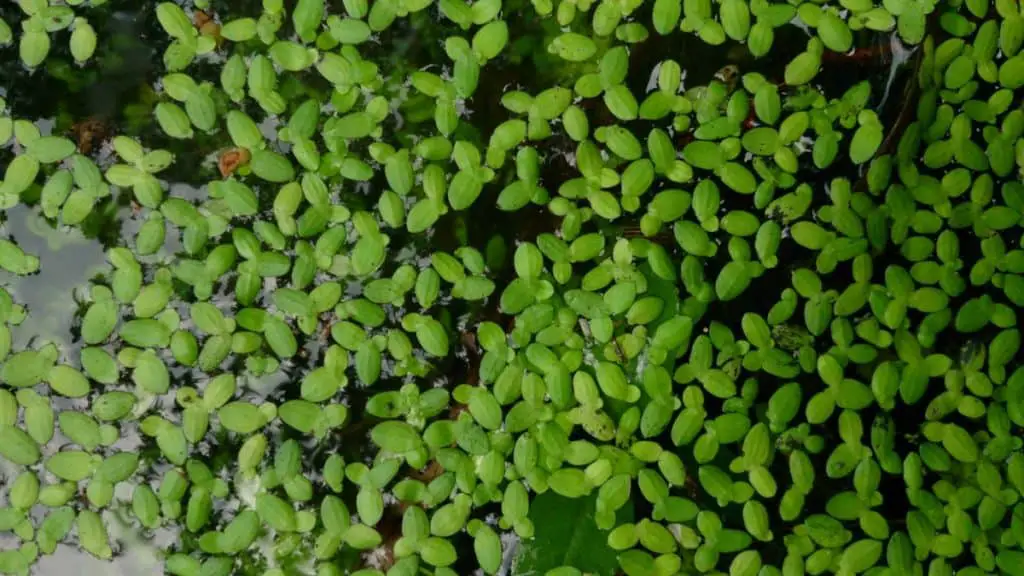
Species Data
Scientific Name Spirodela polyrhiza
Common Name Water Lens and Bayroot
Care Level Easy
Placement Floating
Lighting Natural and moderate
This beautiful and delicate looking floating plant is actually hardier than you might think. It’s fast-growing and can provide vital shelter for young fish and fish that live near the surface.
It can also act as a breeding ground for certain species of fish.
There are pros and cons for keeping duckweed in a home aquarium or ponds for that matter. It has the ability to rapidly grow/spread and take over an aquarium or pond within weeks. Even a very small amount introduced into an aquarium can completely cover the aquarium surface quickly.
If it is allowed to completely cover the surface of the water, it can lead to oxygen deprivation.
You will then need to remove some to allow oxygen to enter the aquarium and harmful gases to release. Removing duckweed is not as easy as it may seem. Removing the majority with a fine fishnet is easy, however, duckweed has an annoying habit of sticking and clinging to everything and getting inside your filter.
So removing it from your aquarium 100% is very difficult.
Duckweed is capable of absorbing large amounts of nutrients and some toxins from the water they grow in. They require their habitat to be very quiet, with very little surface movement of the water. This, plus the fact that they block oxygen from entering the aquarium, means it’s only suitable in certain aquariums.
Duckweed looks beautiful and adds that natural aspect to any aquarium. Just remember that once you add it to your tank, it’s very difficult to remove. You’re in for the long haul.
Read our complete growers guide for Duckweed here.
4. Water Wisteria

Species Data
Scientific Name Hygrophila difformis
Family Acanthaceae
Care Level Easy
Lighting Low-Moderate
Water Conditions 74-82° F, KH 3-8, pH 6.5-7.5
Size 15-20 Inch
Propagation Cuttings
Placement Background
Okay, so you’re looking for a bright green bushy plant that will provide safety and shelter for your fish and put oxygen into the water. Oh, and it’s very easy to grow and inexpensive… Then you need Water Wisteria.
Water wisteria can reach a height of up to 18-20 inches, and a width of around 10-11 inches. It’s a very hardy plant that will need little attention but can block out too much light if left unattended. Trimming this plant regularly will be part of your weekly routine or tank maintenance.
Sold throughout the world as one of the most popular and easy to grow aquarium plants we can see why. I have been keeping water wisteria for over 30 years and I can hardly remember a time when I didn’t have it in one tank or another.
If you’re looking for a background plant that will brighten up your aquarium and look amazing, then this is the plant for you.
3. African Water Fern
Species Data
Scientific Name Bolbitis heudelotii
Care Level Easy
Lighting Moderate
Max Size 20 Inch
Propagation Rhizome division
Placement Background
Temperature 74-84 degrees Fahrenheit
Known by many different common names African Water Fern or Bolbitis heudeloti – if you like to use scientific names – is also sold as Congo Fern and Creeping fern, just to name a couple.
Found in African regions in river beds attached to rocks and wood, it can be found fully submerged or partially submerged, where it’s at home in either environment.
It thrives in fast-moving warm tropical waters. It is an epiphyte and anchors itself to rough rocks or pieces of wood. It uses its roots to firmly attach itself in fast-moving waters.
Never try to plant the roots under the substrate as they will rot and die. Simply attach them to a rock and hold in place with an elastic band or cotton thread until it has taken hold. This is usually within a week or two. Once attached you can remove the thread if you feel the need to do so.
It is a hardy species and easy to grow but does grow very slowly. Don’t expect it to propagate quickly and there’s no fear of it taking over your aquarium any day soon.
2. Tiger Lotus
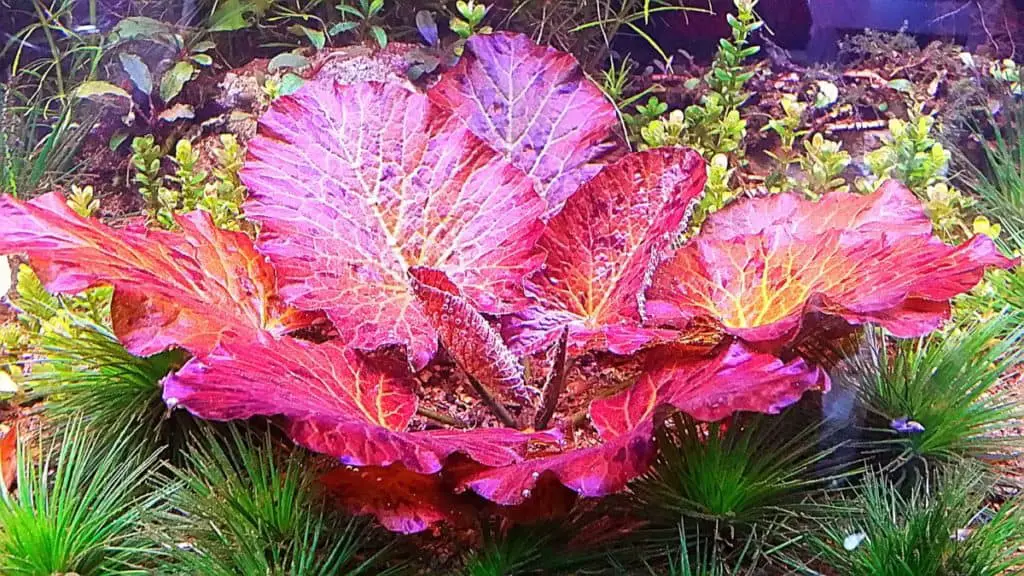
Species Data
Scientific Name Nymphaea lotus
Care Level Easy-Moderate
Lighting Moderate
Max Size 45 cm
Placement Mid-background
pH Levels pH: 5-8
Growth Rate Medium
Now we’re talking… The Tiger Lotus Plants. If there was a title for best looking aquarium plant then this would certainly be in the running. There are many aquarium plants to choose from and so many different colors and shapes but none can beat the Tiger Lotus (my opinion).
Red Tiger Lotus is a plant that is usually bought in bulb form. It has two modes of leaf structures, with the first being completely submersed leaves that look somewhat like lilies. The second mode is floating leaves that float to the surface of the water and stay there for the most part.
We often remove some of the floating leaves as they can block out too much light and affect the growth of other plants. But that’s a small price to pay for their beauty.
When purchasing a new Tiger Lotus bulb you’ll need to inspect the bulb to see if it’s a good one. Press the bulb lightly and it should feel firm. If the bulb is squashy and mushy then it’s rotten and dead. When planting the bulb in your aquarium, just cover the very bottom of the bulb only and leave the rest showing. If you cover the entire bulb it will die quickly.
If I was to say go out and buy any aquarium plant it would be this one. It is simply stunning when given the right water conditions lighting and plant food.
1. Cryptocoryne Beckettii
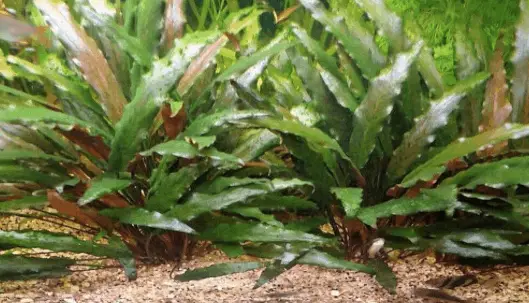
Species Data
Common Name Water Trumpet
Origin Sri Lanka
Care Level Easy
Max Size 4-6 inches
Lighting Moderate
Placement Midground
Propagation side shoots
Let’s finish with a beautiful mid-ground aquarium plant – Cryptocoryne Becketii.
Their leaves become dark brown with a violet color underside. Like many other Cryptocorynes, the leaf color and shape depends largely on environmental conditions in the aquarium. Warmer waters, brighter lights can all play a part in the appearance of this species of aquarium plant.
This is one of the only plants in this list that I would suggest NOT having a strong light as it can burn and discolor the leaves. We suggest a moderate light with slightly alkaline water with a pH between 5.5-8.
It is very tolerant of water temperatures as long as they don’t rapidly change.
Often called water trumpet, it can be found in most stores being sold as a foreground plant. We think it is best suited to mid-ground as the leaves and stems can reach 6 inches in height. Most foreground plants are below 3-4 inches.
Slow growing, it can take several weeks to settle in and for its roots to firmly take hold. It grows very easily even in hard water. The substrate should be a mixture of plant soil-based substrate and fine aquarium gravel. If you purchase yours in a pot you may consider using a plant fertilizer as their roots often don’t get the nutrients they need from standard aquarium gravel
 Many plants featured in this list can grow submerged or above the water
Many plants featured in this list can grow submerged or above the water
level like in this Paludarium
Choosing The Right Plants
To ensure your plants thrive in your aquarium, it is vital that you start off on the right foot by choosing the right plants for your aquarium.
There are several factors to consider when choosing aquarium plants to ensure they grow and thrive in your water conditions. The four main points to look out for when purchasing aquarium plants are:
- Your water pH levels
- Temperature
- The type of fish you keep
- Lighting
Water Conditions
The vast majority of popular aquarium plants pH level of 7 to 7.2. Many fish will enjoy eating your lovely new plants, so make sure you check the compatibility of each plant with your fish.
If you don’t provide the correct water conditions, lighting and suitable inhabitants, your plants simply won’t survive.
Temperature
The average tropical fish tank should be kept at around 26-27 degrees Celsius (79-81 degrees Fahrenheit), it is, therefore, important that the aquarium plants you choose are suited to those temperatures. We have provided all the information you need for each plant on this list to ensure you purchase suitable plants for your aquarium’s temperature.
Substrate
Many plants come pre-potted; these plants are already rooted inside the pot and have a better chance of surviving the first few weeks as they are already established. However, the pots can look unnatural.
Providing the right substrate for your plants will ensure the roots can firmly take hold in your substrate and take all the nutrients they need to grow.
Gravel alone does not offer all the nutrients they need to thrive.
Don’t worry if you just have plain gravel you can add plant food to the water to help them grow. Prices Here On Amazon!
You can purchase a soil-like substrate that goes on the bottom of your aquarium with a layer of aquarium gravel on top. This will provide the best solution for your plants. The roots will take hold in the special soil-like substrate which contains all the nutrients they need to thrive.
Lighting To Help Aquarium Plants Grow
One of the most important parts of growing aquatic plants in a home aquarium is the lighting, your plants simply won’t survive without suitable lights.
Plants need light for photosynthesis; a process in which they generate energy for growth. An added benefit of photosynthesis is that it produces oxygen for the aquatic life in your aquarium. This is part of the life cycle of an aquarium and forms a natural environment for your fish.
Full-spectrum lighting is now available in LED or fluorescent forms. Your new plants will need 10 – 12 hours of light per day. LED lights have a better light spectrum and will last longer than fluorescent. A fluorescent tube will fade over time and will need replacing every year. If your light fails to emit a full spectrum, your plants won’t thrive.
Read 7 BEST LED LIGHTING REVIEW here.
Feeding Aquarium Plants
All living creatures and plants need to feed. Aquatic plants are no different. Provide your plants with a slow-releasing plant fertilizer that is designed to help your freshwater aquarium plants grow. Never use a phosphate fertilizer as algae thrive on phosphates.
Many of the necessary nutrients are provided through the natural aspect of the normal aquarium setup ie: In the substrate and water, these alone are not enough for plant maintenance. Other nutrients need to be provided through the additions of fertilizers or even co2 systems (these are more advanced techniques).
Nutrients that generally need to be provided for planted aquariums are; magnesium, sulfur, potassium, carbon, and phosphorus. There are a few simple ways to provide your plants with these essential nutrients and food sources.
Here are just a couple of the most popular methods, perfect for beginners.
Liquid fertilizers: Liquid fertilizers are available from most good pet/aquatic stores and are one of the easiest ways to provide your plants with food and essential minerals they need to thrive. A good example of these products and one we use is Seachem Flourish Freshwater Plant Supplement.

Click the image for Prices
Tablet fertilizers: These are often a great option for adding extra nutrients which will slowly release throughout the day/weeks. They should not be used as the primary source of nutrients but are great for aquariums with soil-based substrates where you want to add that little bit extra help for your plants. We use Seachem Flourish Tabs Growth Supplement.

Substrates: Nutrient-rich plant substrates are a great way to ensure that there are enough nutrients present for your plants to grow. However, this type of substrate will need to be added in the initial stages of setting up your aquarium. We use Carib Sea Eco Aquarium Substrate.

Click the image for prices
Uneaten fish food and waste: Uneaten fish food and fish waste products contain nutrients needed for plants such as phosphate and potassium. However, this should not be the primary method for fertilizing. Just remember to not overfeed your fish; it will cause excessive amounts of rotting debris and have a negative effect on water conditions. Read what you should do if you think you have overfed your fish here.
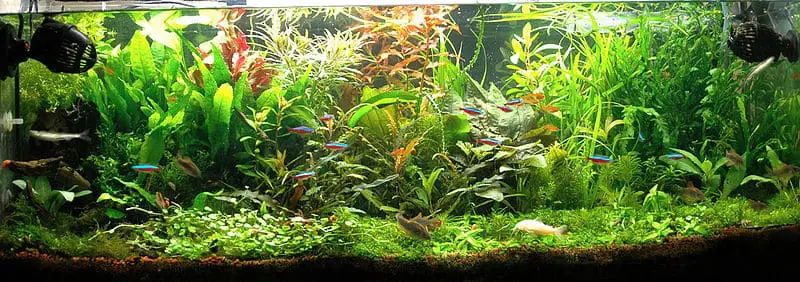 A stunning example of a planted aquarium
A stunning example of a planted aquarium
Conclusion: Best Aquarium Plants 21 Most Popular
Creating a healthy aquarium will not only benefit your fish but enhance your hobby. Adding live aquarium plants can create not only an amazing looking aquarium but also help maintain a healthy aquarium. Aquatic plants will help to create the correct water conditions needed for maintaining a healthy fish population.
Not only do live aquatic plants look good, but they also have lots of benefits for your fish. At the end of the day, we are trying to provide the best environment for your fish – live plants will do that.
Information contained on this page is provided by an independent third-party content provider. Frankly and this Site make no warranties or representations in connection therewith. If you are affiliated with this page and would like it removed please contact pressreleases@franklymedia.com
More Like This
February 24th, 2020
January 2nd, 2025
Top Headlines
June 27th, 2025
June 27th, 2025

